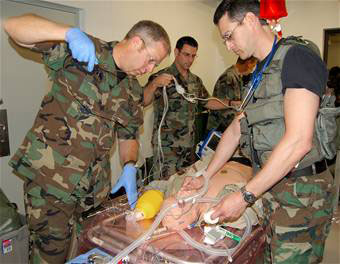 Air Force Special Operations Command has a new course to better familiarize pararescue and paramedic airmen with the world of casualty evacuation, and it includes the use of two “human-simulator” mannequins with computerized sensors that react to treatment. The first two-week course began May 15 at Hurlburt Field, Fla., with five Air Force Reserve Command individual duty medical technicians from the 920th Rescue Wing, Patrick AFB, Fla. According to MSgt. Daniel Arnold, superintendent of AFSOC medevac operations, the mannequins “breathe, bleed, blink, urinate, tear, drool, and secrete fluid from their ears.” If the trainees provide the right treatment, such as giving them epinephrine during cardiac arrest, the mannequins improve; if not, they don’t.
Air Force Special Operations Command has a new course to better familiarize pararescue and paramedic airmen with the world of casualty evacuation, and it includes the use of two “human-simulator” mannequins with computerized sensors that react to treatment. The first two-week course began May 15 at Hurlburt Field, Fla., with five Air Force Reserve Command individual duty medical technicians from the 920th Rescue Wing, Patrick AFB, Fla. According to MSgt. Daniel Arnold, superintendent of AFSOC medevac operations, the mannequins “breathe, bleed, blink, urinate, tear, drool, and secrete fluid from their ears.” If the trainees provide the right treatment, such as giving them epinephrine during cardiac arrest, the mannequins improve; if not, they don’t.
The U.S. began extensive air and artillery strikes against Islamic State group targets in Syria on Dec. 19 in retaliation for the killing of three Americans on Dec. 13 by a gunman affiliated with ISIS, U.S. officials said.

